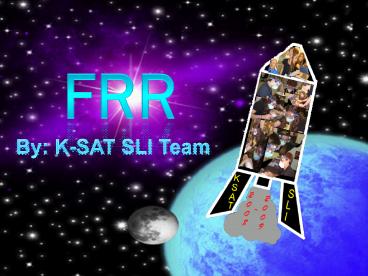CDR - PowerPoint PPT Presentation
1 / 22
Title: CDR
1
FRR
By K-SAT SLI Team
2
The Krueger SLI team will launch a rocket a
mile high and sample the ozone concentration at
various altitudes during descent. Once the data
is recovered it will be compared with ground
level concentration.
3
Changes Since CDR
- Changes made to Vehicle Criteria
- We have changed our main parachute to an 100
instead of a 78. - We also changed the length of the rocket to
93.26 instead of 122.25 - Changes made to Payload Criteria
- We fixed the payload diagram for
the redundant system. - Changes made to Activity Plan
- - The teachers and students gave a TARC/SLI
presentation to the parents and students of
Dellview Elementary during their school Math and
Science Night. - Peter Bella, an Environmental Engineer, from the
Alamo Area Council of Governments (AACOG) has
been contacted to give a presentation about
causes in ozone concentration levels. During the
presentation Mr. Bella will provide relevance to
the project by suggesting our rocket be used to
confirm AACOGs ozone concentration computer
models and predictions. - For the third year, our students will help out
with Science day at Longs Creek Elementary and go
to Wilshire Elementary, too.
4
Mark Twain Atmospheric Sounding Rocket Design
5
Rocket Flight Stability
Rocket Stability Margin CG Location is
65.3170 CP Location is 75.1174 The Mark Twain
II Is stable by a margin of 1.78
6
Motor Selection Comparisons
7
Altitude RockSim Data
8
Acceleration RockSim Data
9
Velocity RockSim Data
10
Parachute Sizes and Descent Rates
- Dual Deployment System
- 36 in. drogue parachute
- 100 in. main parachute
- Velocity at Landing 19.0959 ft/s
11
Launch Guide Data
- Launch guide length96.0000 in.
- Velocity at launch guide departure54.6402 ft/s
- The launch guide was cleared at 0.36 Seconds
- User specified minimum velocity for stable
flight 43.9993 ft/s - Minimum velocity for stable flight reached at
64.5791 in.
12
Test Plans and Procedures
- Altimeter Testing
- Reduce the air in the chamber until the altimeter
reaches around 6000 ft. - Altimeter will fire the first charge.
- Put back the air until the altimeter reaches 750
ft. - The second charge will fire.
- Recovery System Testing
- Put the rocket together and strap down the
payload section to a table or a - sawhorse.
- The altimeter will still be in the vacuum chamber
so we can test the - parachute recovery system.
- The safe distance will be 10 ft. from the rocket.
- The bottom of the rocket will separate from the
payload section to its full - length of the shock cord.
- Ozone data logger will turn on.
- Main parachute will come out of the nose section
to its full length. - All of this will be supervised by a certified
level 3 NAR mentor.
13
Payload Assembly
14
Ozone Sensor Testing
AACOG Sensor
15
Payload Design
Datalogger
16
Payload Integration
- Payloads (control, scientific, and recovery) will
be mounted on an assembly designed to slide in
and out of the rocket airframe. - Assembly will be constructed of wood, fiberglass
cloth, and Epoxy and consist of two bulkheads at
the ends, with a 2-sided, flat mounting surface
spanning the length between the ends. - Two bulkheads will be constructed such that they
are snug with the inner diameter of the airframe
to prevent movement during flight, but will still
be able to be removed as a single unit when
disassembling the rocket. - Payloads will be mounted to the flat surface
using shock mounts to minimize the stresses
transmitted to the payloads during lift-off and
landing. - All electrical interconnects will be secured in a
way to provide adequate stress relief while
preventing inadvertent disconnects. - Air flow to the ozone sensor will be achieved by
a drilling a small hole in the airframe. - The hole will also serve as the air pressure
source for the altimeter.
17
Mark Twain Scale Model
18
Scale Model Time vs. Altitude
19
Scale Model Time vs. Acceleration
20
Scale Model Time vs. Thrust
21
Scale Model Time vs. Velocity
22
Safety
- The Krueger SLI team follows all safety
precautions and directions provided in the MSDS
sheets for potentially hazardous material used
during rocket construction. All safety tables for
risks hazards and failures can be found in our
reports.































